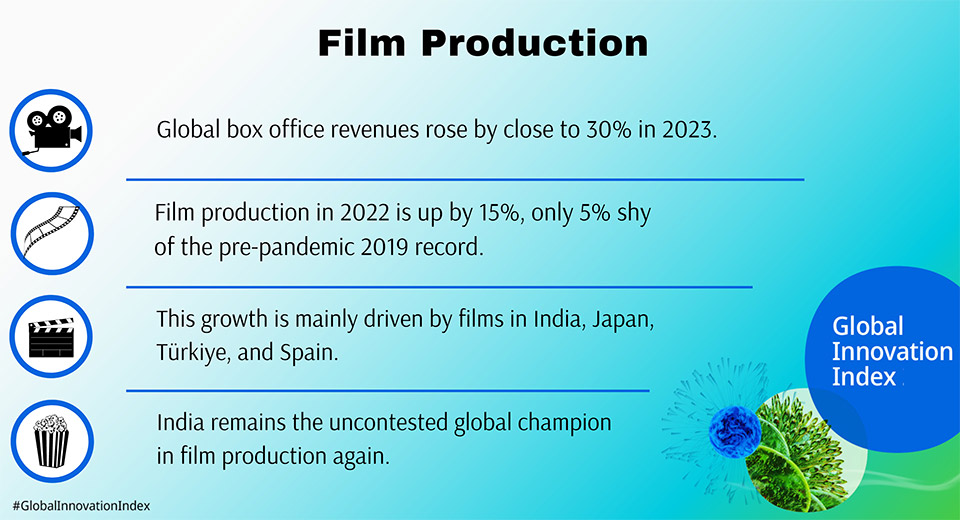Resurgence of Global Cinema: 2022 and 2023 witness forceful comeback but still shy of pre-pandemic norms
March 28, 2024
By David Hancock (Omdia), Jeff Slee and Sacha Wunsch-Vincent (WIPO)
The global movie industry is rebounding fast from the COVID-19 pandemic, with growth in film production driven by India, Türkiye and Spain even as new cinematic output and box office revenues still lag their position at the end of the last decade.
That’s according to newly released figures from WIPO and Omdia, a provider of important creative-industry data used by WIPO in its flagship Global Innovation Index report.

To recall: The COVID-19 pandemic led to a dramatic slide in global movie production, with a 41% decline in feature films produced in 2020 and 72% plummet in global box office revenues in 2020. A main concern for industry watchers was whether this hiatus would leave a lasting effect on cinema attendance and, as a result, on film production.
Fortunately for movie aficionados, recent figures show a robust resurgence of global cinema in 2022 and 2023. Nevertheless, box-office revenues and film production figures are still shy of pre-pandemic levels (see Figures 1 and 2).
- Global box office revenues rose by a provisional 29.4% in 2023 to USD 33.2 billion, following a growth of 21.8% in 2022. This is still close to USD 9 billion short of the global peak in 2019 and thus at 80% of where the market was between 2017-2019[1]. The top three grossing movies globally in 2023 were Barbie, The Super Mario Bros. Movie, and Oppenheimer. Omdia forecasts that nearly all markets will have recovered by 2025/26[2].
- Our latest film data, produced by Omdia in collaboration with the Global Innovation Index (GII) – also shows a continued growth in film production in 2022 – increasing by 15% (+1,152 films) - to total of 8,748 films, softer than the 40% rebound seen in 2021, but only 5% shy of the pre-pandemic record level of close to 9,200 films reached in 2019.
- From a historical perspective, and notwithstanding the pandemic-induced cinema decline, the number of feature films produced in 2022, the second-highest level ever for film production, is more than double the levels seen in 2000, a testament to vibrant world movie production in a digital production and distribution age (see Figure 2).
Figure 1: The state of global cinema (films produced, left axis and box-office revenues, in USD billion, right axis), 2016-2023
Highlights of global film production data
- In a sector recovering from COVID shutdowns, the 2022 growth in film production is mainly driven by India (+679 films), Japan (+144), Türkiye (+111), and Spain (+49). The largest declines are in the United States (-109), China (‑80), and France (-57).
- In 2022, India, home to Bollywood, holds on to the top position with close to 2,500 films, or around 29% of the global volume, gaining an extra 5% of the global share – making it the uncontested global champion in terms of number of films produced (see Table 1 and Figure 3).
- The USA, with its glamorous Hollywood, is second, with a third of the Indian total, capturing around 10% of all feature film productions in the world, marking a three-percentage point decline of its global share. In next year’s GII, we will see the impact of the Writers’ and Actors’ strikes in the US numbers too though likely leading to further falls in 2024.
- Japan surpasses China, moving into third position, with a global share of 7%. Domestic films are driving the Japanese sector, especially anime which is now also gaining popularity around the world.
- China is in fourth, with a global share of 6%, as COVID-19 restrictions were still in place in the country. Local productions are now driving the film sector, taking 85% of the box office earned in 2023.
- Other middle-income economies on the list of top 20 film producing economies worldwide in 2022 are: Mexico, Argentina, Türkiye, Brazil, Russian Federation, Philippines and Iran, in order of number of films produced.
- In Africa, Morocco leaps 19 spots to 45 in the global ranking, increasing from 8 films in 2021 to 25 films in 2022. Egypt sits next at rank 51 (21 films) and South Africa moves to third, with a global unscaled ranking of 53 (20 films).
- Adjusting film production for population size, Iceland leads, followed by Switzerland, Estonia, Czech Republic and Luxembourg. Barbados reports for the first time and makes the top ten, coming in at the sixth spot.
Table 1: Top countries for feature film production, absolute (left) and scaled by population (right), 2022

Figure 2: Annual number of national feature films produced globally, 2000-2020
Figure 3: Annual number of national feature films produced globally, by main movie-producing countries, 2000-2020
Looking forward, cinema revenues in the future will be boosted by new movies based on toys or gaming-related intellectual property (for example, Transformers, Mario Bros., etc.) and new forms of original theatrical content, including live tour concerts (such as the Taylor Swift THE ERAS Tour).
Background
The Global Innovation Index includes a pillar on creative outputs, with three sub-pillars: Intangible assets, Creative goods and services and Online creativity. The number of national feature films indicator is available within this GII Creativity pillar thanks to the WIPO GII collaboration with Omdia. Omdia maintains a range of databases in the film, TV and media sectors, including film production, theatrical distribution and cinema exhibition. You can check individual GII country profiles, for example: China, India or the USA. For more information, visit the GII webpage and Omdia’s film production database (subscription required).